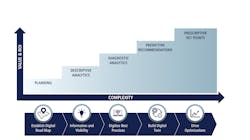Digital transformation roadmap for drinking water systems
Water managers of smaller drinking water systems have come to understand that gathering more operational data and using it to improve efficiency is taking over the industry. As with other industries adopting new technology, digital management of water systems is a matter of when, not if, it is going to happen. Having said that, invariably the first questions from water operators is “How do I get started and what’s it going to cost me?”
Many larger water utilities have already begun their digital journeys by leveraging their larger and more specialized internal teams, but there are thousands of smaller utilities that are earlier in their own journey, contemplating how digital tools can help them operate better now and in the future. It is a tall task. A common pain point is the lack of skilled operators, which has been exacerbated by the pandemic as people left the work force for retirements or other reasons, leaving fewer and less experienced teams behind to complete the same workload.
Add the effects of climate change with drought, floods and extreme weather, new PFAS regulations, cyber-attacks and energy resiliency, and the result is a challenging situation for water utility operators and managers. They must do more with less, manage risk by anticipating and addressing future challenges while replacing an aged infrastructure, many times with doubtful or inadequate funding.
The AWWA State of the Water Industry 2022 Executive Summary identified major challenges faced by water utilities. The new digital water industry has introduced a wide variety of sensor, software and hardware tools with the capabilities to help address 15 of those 20 challenges.
Today’s digital innovation will be tomorrow’s normalcy, but a pivot is required. To make digital water management happen, operators must untangle the complicated array of technologies and find out where to start, what to prioritize and assess both capital and operational costs, as well as associated savings over the current operation.
Defining digital transformation in water utilities
Smaller utilities are looking to digital transformation to improve their operations. So, what is digital transformation?
In a nutshell, it is the process of translating data into information for improved decision making. The transformation starts by assessing what systems a utility already employs, the challenges and needs a digital tool is intended to address, and then performing a gap analysis between the current and intended states.
Digital tools to address the gap are then researched and a digital roadmap is defined to close the performance gap and achieve the intended goals by becoming a more digitally mature utility. Each utility’s transformation is unique. That means the answer to the burning question — How do I start and what’s it going to cost me? — depends on the utility’s situation.
Water utilities typically have some form of the following systems in place, in either a digital or analog form:
- System maps or geographic information system (GIS);
- Customer information system (CIS);
- Supervisory, control and data acquisition (SCADA) system;
- Metering infrastructure, whether direct read or advanced metering infrastructure (AMI);
- Maintenance or work orders management system, whether basic or computerized (CMMS);
- Laboratory information management system (LIMS);
- Operational optimization tools, such as excel spreadsheets;
- Enterprise asset management system (EAMS); and
- Other instrumentation, sensors, software, or analog operational tools.
Breaking down water data silos
The systems listed above commonly do not interact with each other, with data from each system remaining within its own data silo. Data-informed decision-making thus requires significant efforts to access, download, translate and analyze into meaningful formats, meaning that a time-constrained manager often makes decisions with an incomplete picture. The new digital utility upgrades these systems to a digital format and then combines information gathered from these various data sources and operational silos into a real-time integrated data model called a digital dashboard.
Digital dashboards
The data from all systems is gathered into a centralized digital data historian, and the data is translated and curated into meaningful information that operators can use for better-informed decision making. The digital dashboard is then translated into appropriate formats to enable greater mobility for operations teams via access on smartphones, tablets and laptops for utilization by technicians in the field, at home or the office.
Digital twins for water systems
Moving beyond dashboards, digital twins of water systems can be developed to compare scenarios, model changes and conduct training in an offline format that is nearly identical to the physical system. Data science methods such as machine learning and artificial intelligence can then be applied to the digital twin of a system to provide early awareness of risks and offer optimized setpoint recommendations, saving electricity, chemicals and other benefits.
An example of a small utility digital journey
For example, assume there is a theoretical small community in the western United States, with 5,000 water connections. The utility has begun its digital journey by implementing a GIS system, so that operators know where the system assets are located, along with an inventory of their parameters. It has a separate paper-based work order system, an outdated renewal and replacement (R&R) plan and old hydraulic model.
The initial goal is to implement a computerized maintenance management system (CMMS) that is integrated with the GIS system so that work orders and asset conditions can be tracked and verified over time to better inform capital investment decisions. Then, when customer complaints come in, nearby system conditions can be verified from the newly integrated GIS and CMMS system, and if needed, work orders can be sent out to address the situation.
The next step for this small town is to fully utilize available and relevant technologies to set and prioritize an R&R or capital investment plan (CIP). With aging infrastructure, there will likely always be more assets beyond their intended life in need of replacement than capital budgets allow for. Therefore, modern data solutions must step in to aid in identifying the most critical needs for the available R&R budgets. Combining an accurate hydraulic or process model of the current system with a projection of future capacity and compliance needs is key, which then needs to be compared to the risk and consequence of failure of the existing assets in order to set a holistic plan.
The combination of these complex and interrelated elements requires a digital platform solution. Take a distribution system for example. The operator knows what type of pipe it has and where it is installed, but what are the correct sizing and pressures that are going to be needed in the future?
Hydraulic modeling is linked into the dashboard and deficiencies are identified. Data science considers soil conditions that can affect pipe longevity. What contractor installed it? Can real-time pressure control management be implemented to lower pressure when demand is less and extend asset life? The dashboard also makes diagnosis more accurate, saving time and money.
If a field technician can view real-time pressure on a tablet and see that the system pressure is 62 psi outside the house of a customer that is complaining of low water pressure, then the technician knows the problem is in the house, not the system.
The utility leader for the small town can now shift from uncertain and generalized estimates of asset replacement needs to a more confident, scientific approach. The utility can add features and new systems — such as advanced sensors to collect operational data — to the digital platform as budget allows and it makes operational sense.
While cost is always a challenge, today’s software platforms come in the form of software as a service where data is stored in the cloud. There are no IT infrastructure costs for servers or other on-premises items which are now provided in a centralized fashion. Software updates and security upgrades are continuously updated by the provider along with timely, integrated helpdesk support.
The drinking water community already knows the strengths and weaknesses of its infrastructure. It knows how to complete renewals and replacements. However, prioritizing what assets to improve is a larger challenge. With tools such as a digital twin, data science methodologies such as machine learning and artificial intelligence, priorities can be managed so that money is spent where it is needed as defined by data, rather than by mere instinct or guesswork.
The digital water roadmap
The first step in the digital journey is the most important, but each utility’s case is unique. So what does a unique digital transformation look like? Here are the steps.
Roadmap process
The roadmap writing process starts with a thorough site assessment typically led by a consulting owner’s engineer. After obtaining system descriptions, understanding existing data sources and historic data availability, the engineer then interviews key personnel in operations, engineering, leadership and finance, researches the regulatory context and performs an on-site visit. All this goes into the existing conditions engineering report.
Engineers then perform a multi-dimension gap analysis – basically what a utility has, does not have and what it will take to achieve project and digital goals – and then researches technology providers and products with the capabilities to close the identified gaps. A cost-benefit analysis is then completed, leading to an initial draft of the four-step journey to the project goals. Feedback is then incorporated, any further needed scenarios are evaluated and the roadmap is finalized. Depending on the utility size and complexity, the roadmap process can typically be completed within four months.
With a roadmap in place, a utility can analyze its entire operation and know what it will require to implement impactful digital tools. The roadmap is used to make cases for capital investment and obtain the budgets that will provide long-term value.
How to get started is the first answer to the two-part question that utility operators regularly ask. The second common question is how much it will cost, and that depends on the current state of a utility and where it wants to be with digital systems in the near- and long-term. There is a wide range of costs depending on the extent and sophistication of the digital systems that are implemented, but the overall idea is that going digital more than pays for itself through more efficient operations and mitigated risks. A sound digital roadmap will clearly show the costs and benefits of the journey to becoming a digital utility.
About the Author
Steve Green
Digital Water Practice Leader
Steve Green is the digital water practice leader at Stanley Consultants. Steve has spent his 23-year career in business development and project delivery roles in the water industry, helping water system owners improve their infrastructure via technology adoption and collaborative project delivery. Steve holds a bachelor’s degree in bio-resources engineering from Montana State University and an MBA from the University of Washington.

